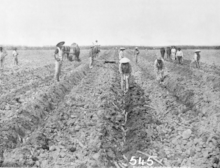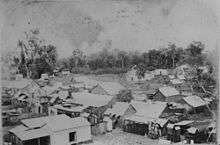Andrew Leon
Andrew Leon (circa 1841-1920) was a Chinese-born Australian businessman in northern Queensland, predominantly in the Cairns district. He established the first sugarcane plantation and sugar mill in Far North Queensland.[1]

Early life
Leon came from Zhongshan, China. He settled in Queensland in 1866.[1] Leon became a naturalised British subject in 1869.[2][3][4]
Cairns businesses
Leon was an early arrival in Cairns in 1876 where he established one of the first Chinese businesses and purchased its allotment. Two years later he commenced Hap Wah plantation (1878-1886) that pioneered the Cairns district sugarcane industry.[5]
In 1881 Andrew Leon and 100 other Chinese businessmen formed a co-operative of shareholders to cultivate a selection known as Portion 52, owned by Leon. This was the first large scale sugar cultivation in far north Queensland. The mill, known as "Hop Wah Pioneer", was opened in August 1881 with Andrew Leon as its manager. The opening was a large event attracting many stakeholders and official guests.[6] The plantation and mill were most probably located along Mulgrave Road (formerly Hap Wah Road and Hop Wah Road) in Woree.[7] The mill and its assets were sold in 1886 and Andrew Leon concentrated his business interests in Sachs Street, Cairns (renamed Grafton Street in the 1930s). Andrew Leon was an innovative agriculturalist and businessman who represented the Cairns Chinese community on official occasions, presenting welcome addresses from the Chinese community, acted as an interpreter in court, and provided the means for preserving cultural linkages as one of the principle trustees for the Lit Sung Goong Temple.[8]

The growing agricultural industry in the Cairns region supported a large number of Chinese in industries such as market gardening and shop keeping. In 1886 the Chinese population of Cairns accounted for 60% of all farmers and 90% of all market gardeners, and Sachs Street was recognized as a focus for Chinese activities. Chinese businesses in Sachs Street included boarding houses, gaming houses, opium dens and merchant stores.[8]
Ten years after arriving in Cairns, Andrew Leon purchased allotment 18 Section 27 off Robert Philp in 1886. The allotment was subdivided into two allotments and the Lit Sung Goong Temple was constructed.[8]
In 1892 Andrew Leon took out a substantial mortgage with the Queensland National Bank for £200 (and further advances) on Lot 2 Allotment 18. The next year four shops were noted for the first time in the Cairns Municipal Rates Book on Lot 2, Allotment 18. A Chinese bricklayer Lee Bat was noted by The Cairns Post in October 1896 as working in the district and the Cairns Argus noted that the Temple on Lot 1 had a great brick oven.[8]
Andrew Leon leased the property to merchants Lee Yan Kee, a consortium of four brothers. One of the brothers Lee Yan, brought his wife and a child servant from China in 1895 and they are the first Chinese women to arrive directly from China to live in Chinatown. They then lived behind the adjoining timber building until 1902.[8]
In late 1902 Andrew Leon took out another loan for £200, this time with the Bank of North Queensland. Two shops on the site were subleased to a Chinese man and a Japanese prostitute O'Kunato in 1903. This was the beginning of a long association with the property being used to house women who worked as prostitutes. Three Japanese women worked at different periods from the shop until 1922. In October 1908 Andrew Leon entered an arrangement with Goon Chew who had placed a caveat over the land until it was purchased by another leading merchant Willie Ming in 1911. When he purchased it he also took over Andrew Leon's mortgage. The place was sold on in 1914.[8]
In the 1930s Sachs Street was renamed Grafton Street through the efforts of the city's alderman to clean up the image of the area and Andrew Leon's building became 99 Grafton Street. After the Second World War the area was used commercially in the same way as the rest of the Cairns central business district. However, the now heritage-listed building at 99 Grafton street and another at 55 Grafton Street, the former Sun Wo Tiy building, are believed to be the last remaining structures directly associated with the former Cairns Chinatown and that archaeological research would reveal Chinese artifacts.[8]
Later life
On 27 June 1920 Andrew Leon died at his home in McLeod Street, Cairns, from cancer aged 80 years.[1] His funeral was held at St Monica's Roman Catholic Church (the predecessor of St Monica's Old Cathedral) in Cairns and he was buried in the Martyn Street Cemetery.[9]
Leon Close in Brinsmead, Cairns, is named after him.[10]
References
- Bolton, G. C.; Cronin, Kathryn. Leon, Andrew (1841–1920). Canberra: National Centre of Biography, Australian National University. Archived from the original on 20 July 2020. Retrieved 10 April 2016.
- "Naturalisations 1851 to 1904". Queensland Government. 10 July 2019. Archived from the original on 20 July 2020. Retrieved 20 July 2020.
- "Item ID882294, Certificates of naturalisation - Supreme Court, Brisbane". Queensland State Archives.
- "Item ID841186, Register of aliens to whom oaths of allegiance were administered". Queensland State Archives.
- Lit Sung Goong Cairns 1887-1966 & Andrew Leon, Trustee. Cairns: Hap Wah & Andrew Leon Historical Project. 2016.
- "EARLY NORTH QUEENSLAND CAIRNS & HINTERLAND". Townsville Daily Bulletin. LXXV. Queensland, Australia. 3 January 1955. p. 5. Retrieved 10 April 2016 – via National Library of Australia.
- Cairns Post Limited (1931), The life of A.J. Draper, The Cairns Post, p. 25, retrieved 10 April 2016
- "99 Grafton St (entry 602511)". Queensland Heritage Register. Queensland Heritage Council. Retrieved 1 August 2014.
- "Demise of Andrew Leon". Cairns Post. XXXIII (3704). Queensland, Australia. 28 June 1920. p. 4. Retrieved 10 April 2016 – via National Library of Australia.
- "'L' street names" (PDF). Cairns Heritage Page. Cairns Regional Council. p. 4. Archived (PDF) from the original on 20 April 2016. Retrieved 10 April 2016.
Attribution
![]()
External links
- "Hap Wah Research". Cairns & District Chinese Association Inc. Retrieved 10 April 2016.
- "Cairns Lit Sung Goong Temple". Cairns & District Chinese Association Inc. Retrieved 10 April 2016.